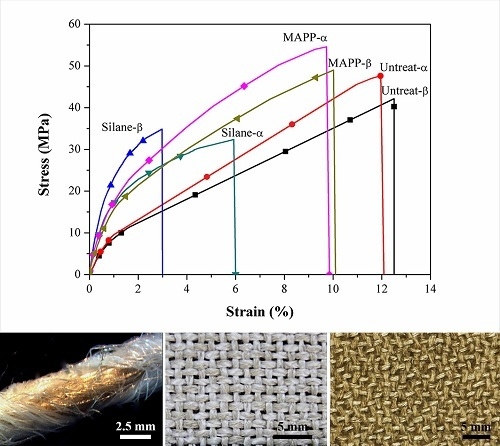Effects of Surface Modification on the Mechanical Properties of Flax/β-Polypropylene Composites
Abstract
:1. Introduction
2. Results and Discussion
2.1. Tensile Properties
2.2. Flexural Properties
2.3. Impact Properties
2.4. Effects of Water Uptake on the Flexural and Impact Properties of Flax/PP Composites
3. Experimental
3.1. Materials
3.2. Fiber Surface Treatment
3.3. Sample Preparation
3.4. Mechanical Tests
4. Conclusions
Acknowledgments
Author Contributions
Conflicts of Interest
References
- John, M.J.; Anandjiwala, R.D. Recent developments in chemical modification and characterization of natural fiber-reinforced composites. Polym. Compos. 2008, 29, 187–207. [Google Scholar] [CrossRef]
- Xie, Y.; Hill, C.A.; Xiao, Z.; Militz, H.; Mai, C. Silane coupling agents used for natural fiber/polymer composites: A review. Compos. Part A 2010, 41, 806–819. [Google Scholar] [CrossRef]
- Kabir, M.; Wang, H.; Lau, K.; Cardona, F. Chemical treatments on plant-based natural fibre reinforced polymer composites: An overview. Compos. Part B 2012, 43, 2883–2892. [Google Scholar] [CrossRef]
- Bajpai, P.K.; Singh, I.; Madaan, J. Comparative studies of mechanical and morphological properties of polylactic acid and polypropylene based natural fiber composites. J. Reinf. Plast. Compos. 2012, 31, 1712–1724. [Google Scholar] [CrossRef]
- Kannan, T.G.; Wu, C.M.; Cheng, K.B. Effect of different knitted structure on the mechanical properties and damage behavior of flax/PLA (poly lactic acid) double covered uncommingled yarn composites. Compos. Part B 2012, 43, 2836–2842. [Google Scholar] [CrossRef]
- Kannan, T.G.; Wu, C.M.; Cheng, K.B.; Wang, C.Y. Effect of reinforcement on the mechanical and thermal properties of flax/polypropylene interwoven fabric composites. J. Ind. Text. 2012, 42, 417–433. [Google Scholar] [CrossRef]
- Bajpai, P.K.; Singh, I.; Madaan, J. Development and characterization of PLA-based green composites: A review. J. Thermoplast. Compos. Mater. 2012, 27, 52–81. [Google Scholar] [CrossRef]
- Bledzki, A.; Gassan, J. Composites reinforced with cellulose based fibres. Prog. Polym. Sci. 1999, 24, 221–274. [Google Scholar] [CrossRef]
- George, J.; Sreekala, M.; Thomas, S. A review on interface modification and characterization of natural fiber reinforced plastic composites. Polym. Eng. Sci. 2001, 41, 1471–1485. [Google Scholar] [CrossRef]
- Yan, L.; Chouw, N.; Jayaraman, K. Flax fibre and its composites—A review. Compos. Part B 2014, 56, 296–317. [Google Scholar] [CrossRef]
- Yan, L.; Kasal, B.; Huang, L. A review of recent research on the use of cellulosic fibres, their fibre fabric reinforced cementitious, geo-polymer and polymer composites in civil engineering. Compos. Part B 2016, 92, 94–132. [Google Scholar] [CrossRef]
- Yan, L.; Chouw, N. Crashworthiness characteristics of flax fibre reinforced epoxy tubes for energy absorption application. Mater. Des. 2013, 51, 629–640. [Google Scholar] [CrossRef]
- Yan, L.; Chouw, N. Natural FRP tube confined fibre reinforced concrete under pure axial compression: A comparison with glass/carbon FRP. Thin-Walled Struct. 2014, 82, 159–169. [Google Scholar] [CrossRef]
- Yan, L.; Su, S.; Chouw, N. Microstructure, flexural properties and durability of coir fibre reinforced concrete beams externally strengthened with flax FRP composites. Compos. Part B 2015, 80, 343–354. [Google Scholar]
- Yan, L.; Chouw, N.; Jayaraman, K. Lateral crushing of empty and polyurethane-foam filled natural flax fabric reinforced epoxy composite tubes. Compos. Part B 2014, 63, 15–26. [Google Scholar] [CrossRef]
- Yan, L.; Chouw, N.; Jayaraman, K. Effect of triggering and polyurethane foam-filler on axial crushing of natural flax/epoxy composite tubes. Mater. Des. 2014, 56, 528–541. [Google Scholar] [CrossRef]
- Van de Weyenberg, I.; Ivens, J.; De Coster, A.; Kino, B.; Baetens, E.; Verpoest, I. Influence of processing and chemical treatment of flax fibres on their composites. Compos. Sci. Technol. 2003, 63, 1241–1246. [Google Scholar] [CrossRef]
- Van de Weyenberg, I.; Truong, T.C.; Vangrimde, B.; Verpoest, I. Improving the properties of UD flax fibre reinforced composites by applying an alkaline fibre treatment. Compos. Part A 2006, 37, 1368–1376. [Google Scholar] [CrossRef]
- Yan, L.; Chouw, N.; Yuan, X. Improving the mechanical properties of natural fibre fabric reinforced epoxy composites by alkali treatment. J. Reinf. Plast. Compos. 2012, 31, 425–437. [Google Scholar] [CrossRef]
- Yan, L. Effect of alkali treatment on vibration characteristics and mechanical properties of natural fabric reinforced composites. J. Reinf. Plast. Compos. 2012, 31, 887–896. [Google Scholar] [CrossRef]
- Kapoor, M.; Beg, Q.K.; Bhushan, B.; Singh, K.; Dadhich, K.; Hoondal, G. Application of an alkaline and thermostable polygalacturonase from Bacillus sp. MG-cp-2 in degumming of ramie (Boehmeria nivea) and sunn hemp (Crotalaria juncea) bast fibres. Process Biochem. 2001, 36, 803–807. [Google Scholar] [CrossRef]
- Privas, E.; Navard, P. Preparation, processing and properties of lignosulfonate–flax composite boards. Carbohydr. Polym. 2013, 93, 300–306. [Google Scholar] [CrossRef] [PubMed]
- Jähn, A.; Schröder, M.; Füting, M.; Schenzel, K.; Diepenbrock, W. Characterization of alkali treated flax fibres by means of ft raman spectroscopy and environmental scanning electron microscopy. Spectrochim. Acta Part A 2002, 58, 2271–2279. [Google Scholar] [CrossRef]
- Cantero, G.; Arbelaiz, A.; Llano-Ponte, R.; Mondragon, I. Effects of fibre treatment on wettability and mechanical behaviour of flax/polypropylene composites. Compos. Sci. Technol. 2003, 63, 1247–1254. [Google Scholar] [CrossRef]
- Awal, A.; Cescutti, G.; Ghosh, S.; Müssig, J. Interfacial studies of natural fibre/polypropylene composites using single fibre fragmentation test (SFFT). Compos. Part A 2011, 42, 50–56. [Google Scholar] [CrossRef]
- Park, J.-M.; Quang, S.T.; Hwang, B.-S.; DeVries, K.L. Interfacial evaluation of modified jute and hemp fibers/polypropylene (PP)-maleic anhydride polypropylene copolymers (PP-MAPP) composites using micromechanical technique and nondestructive acoustic emission. Compos. Sci. Technol. 2006, 66, 2686–2699. [Google Scholar] [CrossRef]
- Kazayawoko, M.; Balatinecz, J.; Woodhams, R.; Law, S. Effect of ester linkages on the mechanical properties of wood fiber-polypropylene composites. J. Reinf. Plast. Compos. 1997, 16, 1383–1406. [Google Scholar]
- Arbelaiz, A.; Fernandez, B.; Cantero, G.; Llano-Ponte, R.; Valea, A.; Mondragon, I. Mechanical properties of flax fibre/polypropylene composites. Influence of fibre/matrix modification and glass fibre hybridization. Compos. Part A 2005, 36, 1637–1644. [Google Scholar] [CrossRef]
- Hill, C.A.; Khalil, H.A.; Hale, M.D. A study of the potential of acetylation to improve the properties of plant fibres. Ind. Crops Prod. 1998, 8, 53–63. [Google Scholar] [CrossRef]
- Nachtigall, S.M.; Cerveira, G.S.; Rosa, S.M. New polymeric-coupling agent for polypropylene/wood-flour composites. Polym. Test. 2007, 26, 619–628. [Google Scholar] [CrossRef]
- Wang, B.; Panigrahi, S.; Tabil, L.; Crerar, W.; Sokansanj, S. Modification of flax fibres by chemical treatment. In Proceedings of the CSAE/SCGR Meeting, Montreal, QC, Canada, 6–9 July 2003.
- Arbelaiz, A.; Fernandez, B.; Ramos, J.; Retegi, A.; Llano-Ponte, R.; Mondragon, I. Mechanical properties of short flax fibre bundle/polypropylene composites: Influence of matrix/fibre modification, fibre content, water uptake and recycling. Compos. Sci. Technol. 2005, 65, 1582–1592. [Google Scholar] [CrossRef]
- Herrera-Franco, P.; Valadez-Gonzalez, A. A study of the mechanical properties of short natural-fiber reinforced composites. Compos. Part B 2005, 36, 597–608. [Google Scholar] [CrossRef]
- Bessadok, A.; Marais, S.; Gouanvé, F.; Colasse, L.; Zimmerlin, I.; Roudesli, S.; Métayer, M. Effect of chemical treatments of alfa (Stipa tenacissima) fibres on water-sorption properties. Compos. Sci. Technol. 2007, 67, 685–697. [Google Scholar] [CrossRef]
- Lotz, B.; Wittmann, J.; Lovinger, A. Structure and morphology of poly(propylenes): A molecular analysis. Polymer 1996, 37, 4979–4992. [Google Scholar] [CrossRef]
- Čermák, R.; Obadal, M.; Ponížil, P.; Polášková, M.; Stoklasa, K.; Hečková, J. Injection-moulded α-and β-polypropylenes: II. Tensile properties vs. Processing parameters. Eur. Polym. J. 2006, 42, 2185–2191. [Google Scholar] [CrossRef]
- Yu, T.; Wu, C.-M.; Wang, C.-J.; Rwei, S.-P. Effects of surface modifications on the interfacial bonding of flax/β-polypropylene composites. Compos. Interfaces 2013, 20, 483–496. [Google Scholar] [CrossRef]
- Rozman, H.D.; Saad, M.J.; Mohd Ishak, Z.A. Modification of oil palm empty fruit bunches with maleic anhydride: The effect on the tensile and dimensional stability properties of empty fruit bunch/polypropylene composites. J. Appl. Polym. Sci. 2003, 87, 827–835. [Google Scholar] [CrossRef]
- Jiang, J.; Chen, N. Preforms and composites manufactured by novel flax/polypropylene cowrap spinning method. J. Compos. Mater. 2012, 46, 2097–2109. [Google Scholar] [CrossRef]
- Wu, C.M.; Lin, P.C.; Tsai, C.T. Fabrication and mechanical properties of self-reinforced polyester composites by double covered uncommingled yarn. Polym. Compos. 2015. [Google Scholar] [CrossRef]
- Wu, C.M.; Lai, W.Y. Mechanical and open hole tensile properties of self-reinforced PET composites with recycled PET fiber reinforcement. J. Appl. Polym. Sci. 2016. [Google Scholar] [CrossRef]
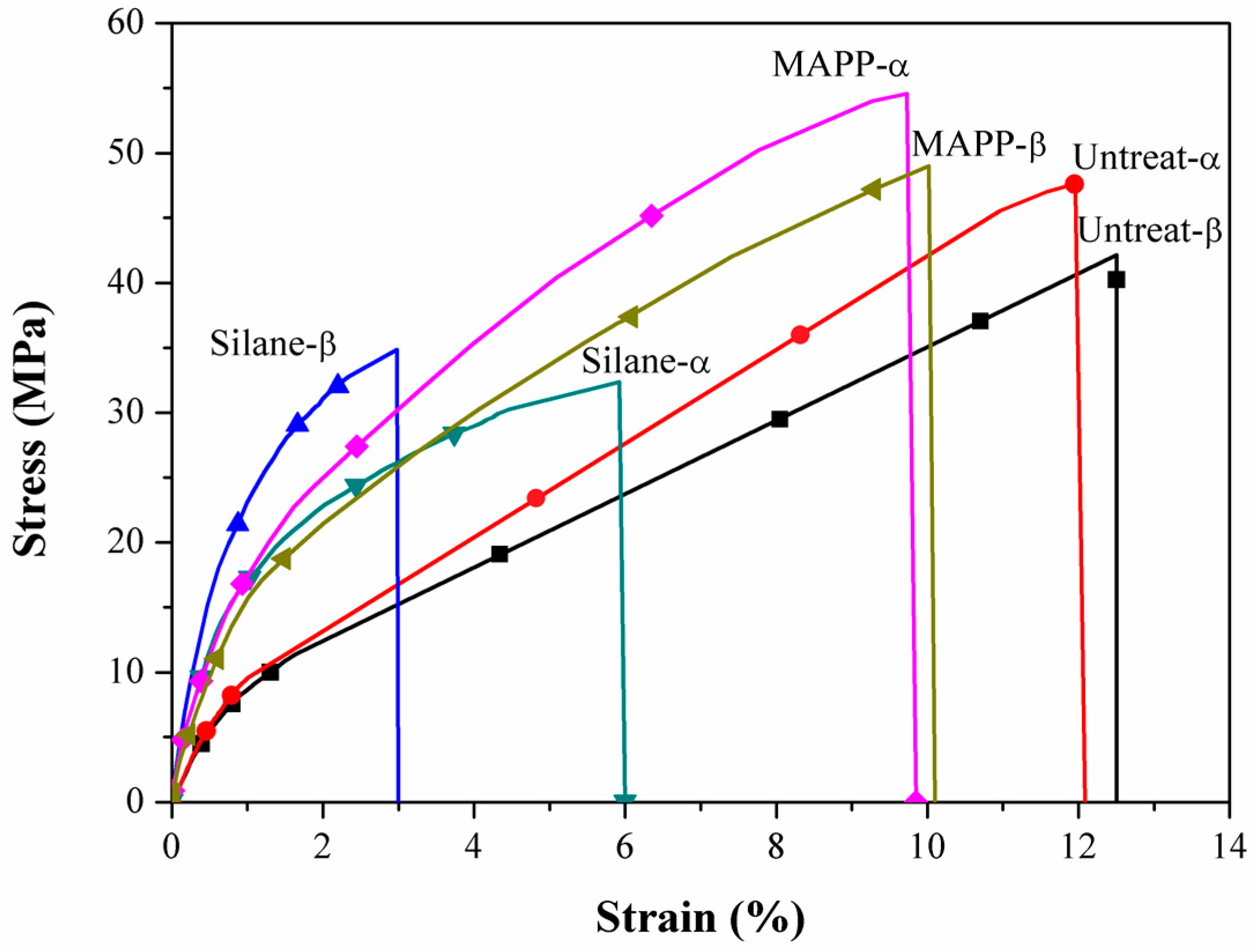


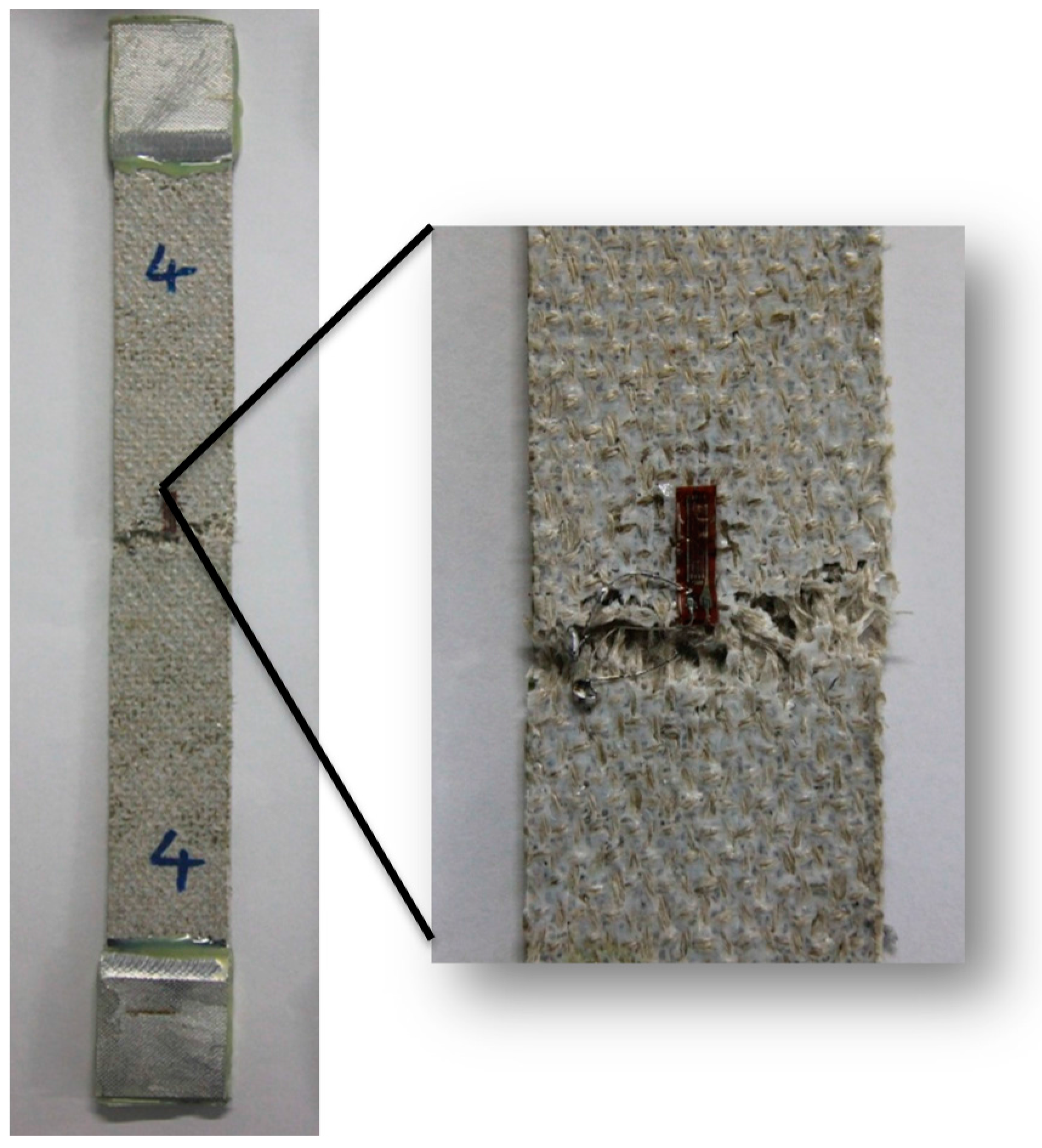
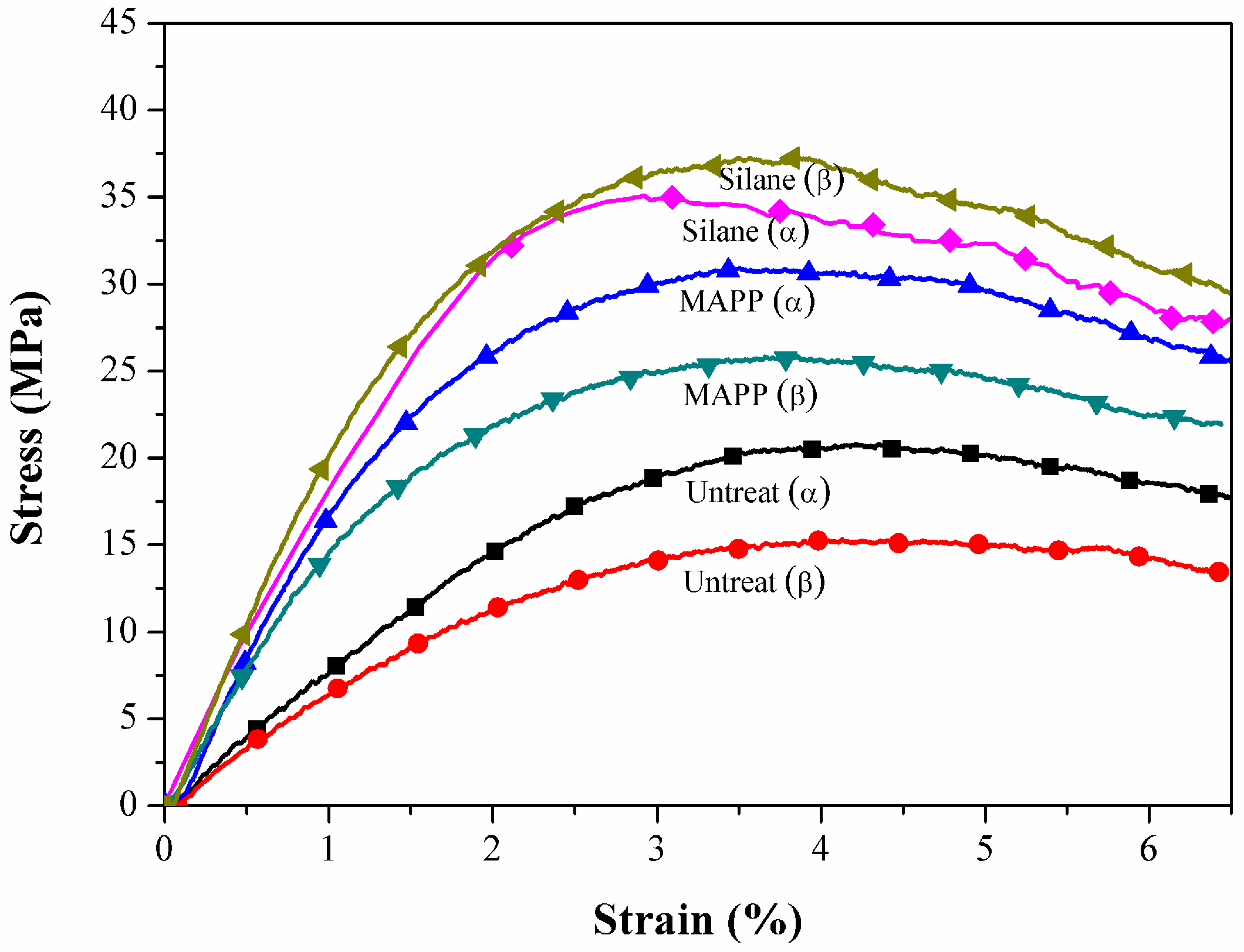
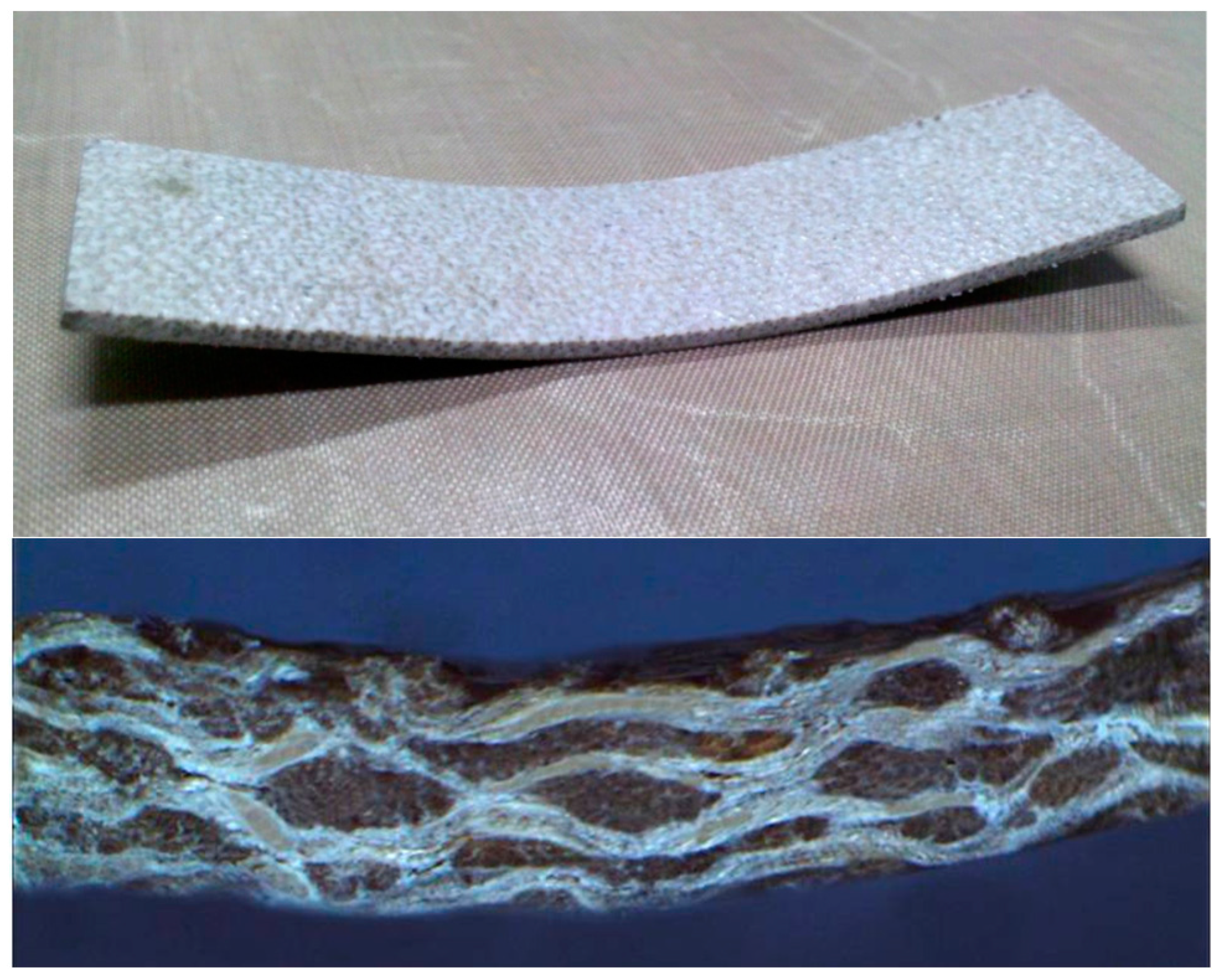
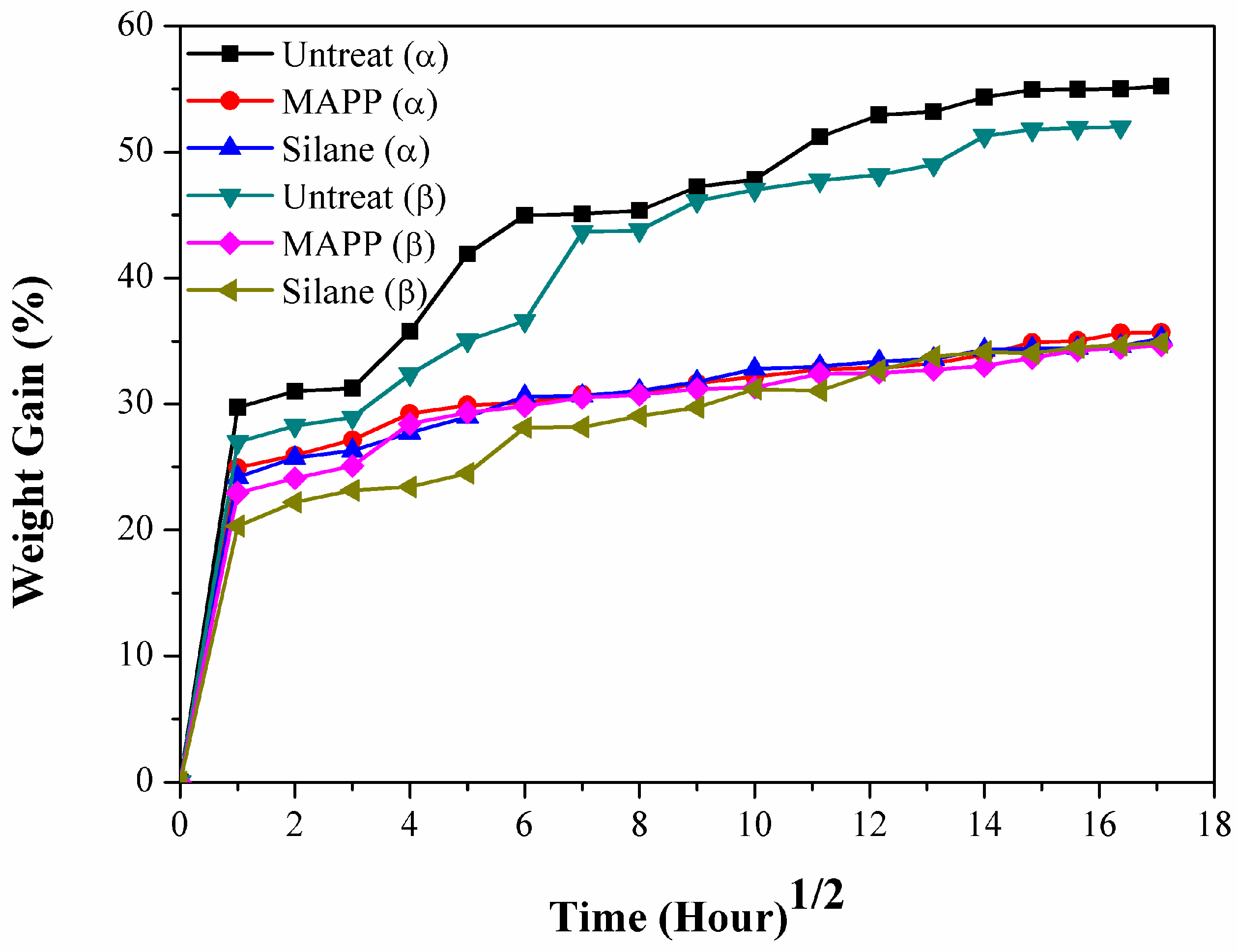
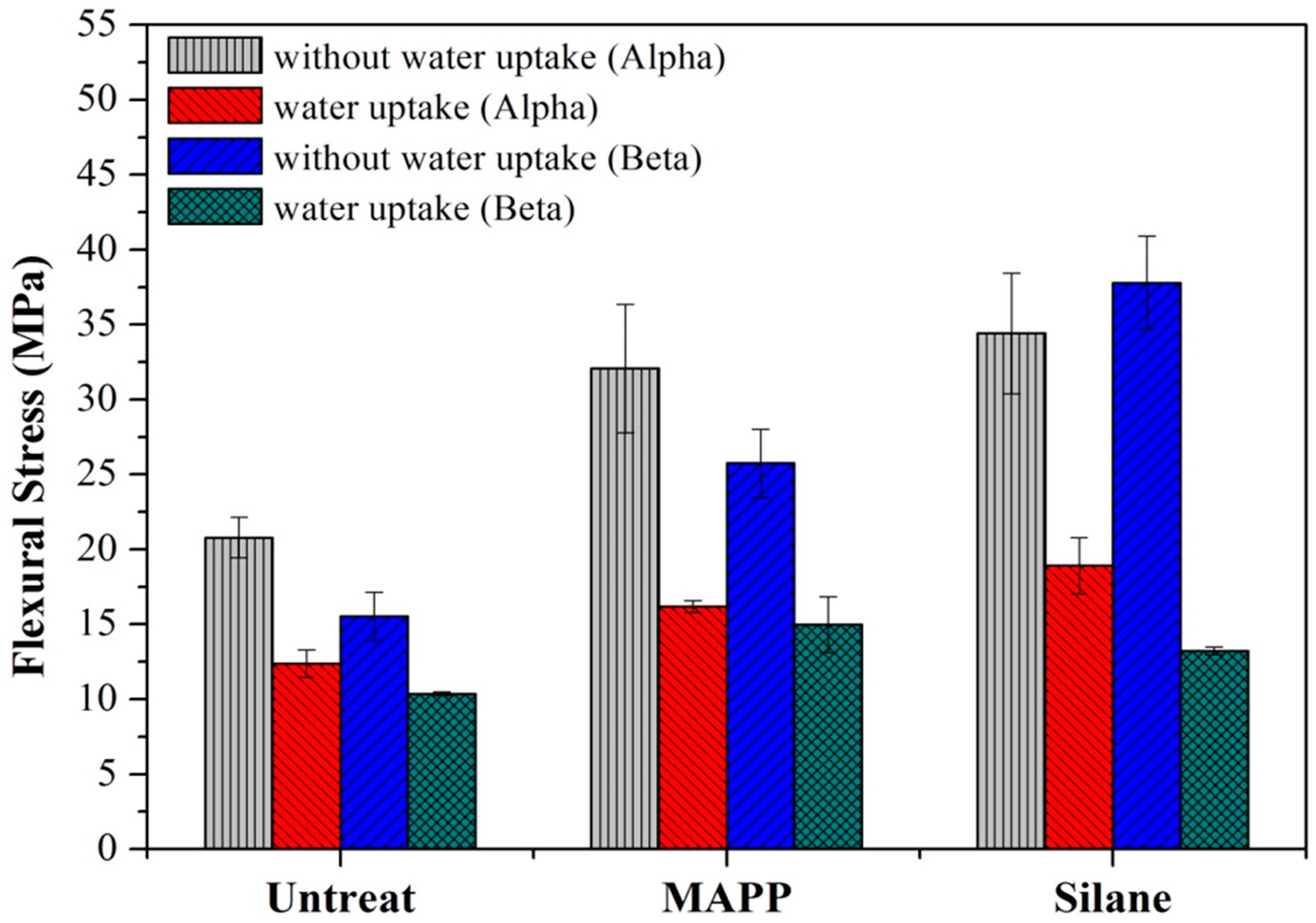
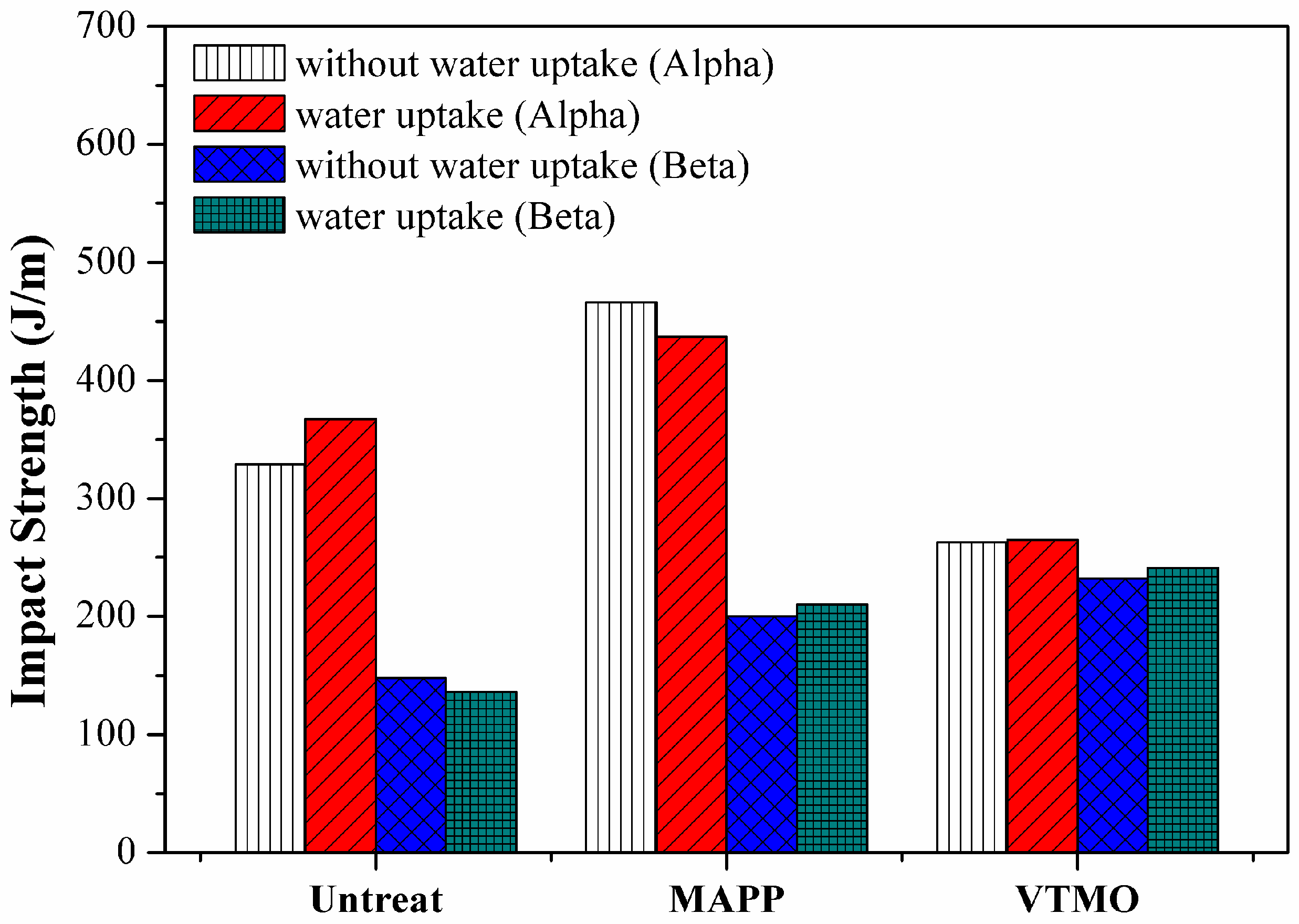

| Resin | α-PP | β-PP | ||||
|---|---|---|---|---|---|---|
| Treatment | Untreated | MAPP | VTMO | Untreated | MAPP | VTMO |
| Strength (MPa) | 46.4 ± 2.4 | 53.1 ± 2.8 | 31.8 ± 3.7 | 42.8 ± 0.6 | 48.8 ± 2.8 | 34.5 ± 4.0 |
| Strain (%) | 12.1 ± 1.1 | 10.7 ± 1.6 | 6.0 ± 0.7 | 12.5 ± 0.9 | 11.1 ± 0.2 | 2.7 ± 0.3 |
| Modulus (GPa) | 1.56 ± 0.23 | 2.97 ± 0.62 | 3.01 ± 0.44 | 1.66 ± 0.22 | 2.65 ± 0.15 | 3.97 ± 0.15 |
| Resin | α-PP | β-PP | ||||
|---|---|---|---|---|---|---|
| Treatment | Untreated | MAPP | VTMO | Untreated | MAPP | VTMO |
| Strength (MPa) | 20.8 ± 1.4 | 32.1 ± 4.3 | 34.4 ± 4.0 | 15.5 ± 1.6 | 25.8 ± 2.3 | 37.8 ± 3.1 |
| Modulus (GPa) | 0.81 ± 0.08 | 1.73 ± 0.19 | 1.96 ± 0.23 | 0.59 ± 0.07 | 1.13 ± 0.17 | 2.19 ± 0.13 |
| Impact energy (J/m) | 329 ± 21 | 466 ± 3 | 263 ± 19 | 367 ± 18 | 437 ± 19 | 265 ± 11 |
| Sample | Strength (cN/tex) | Strain (%) |
|---|---|---|
| Flax (Untreated) | 230.57 | 0.86 |
| Flax (VTMO) | 300.23 | 1.25 |
| Flax (MAPP) | 274.16 | 1.12 |
| α-PP | 39.64 | 29.63 |
| β-PP | 30.94 | 32.04 |
© 2016 by the authors; licensee MDPI, Basel, Switzerland. This article is an open access article distributed under the terms and conditions of the Creative Commons Attribution (CC-BY) license (http://creativecommons.org/licenses/by/4.0/).
Share and Cite
Wu, C.-M.; Lai, W.-Y.; Wang, C.-Y. Effects of Surface Modification on the Mechanical Properties of Flax/β-Polypropylene Composites. Materials 2016, 9, 314. https://doi.org/10.3390/ma9050314
Wu C-M, Lai W-Y, Wang C-Y. Effects of Surface Modification on the Mechanical Properties of Flax/β-Polypropylene Composites. Materials. 2016; 9(5):314. https://doi.org/10.3390/ma9050314
Chicago/Turabian StyleWu, Chang-Mou, Wen-You Lai, and Chen-Yu Wang. 2016. "Effects of Surface Modification on the Mechanical Properties of Flax/β-Polypropylene Composites" Materials 9, no. 5: 314. https://doi.org/10.3390/ma9050314





